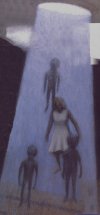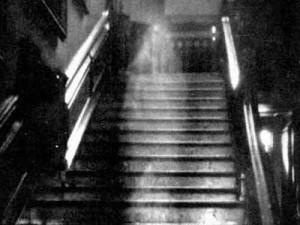“We fear violence less than our own feelings. Personal, private, solitary pain is more terrifying than what anyone else can inflict.”—Jim Morrison
In his book Witnessed: The True Story of the Brooklyn Bridge UFO Abduction, Budd Hopkins, the well-known artist and UFO abduction investigator, reports on the abduction of Linda Cortile (not her real name) and the various other people involved in the case. It is one of the most bizarre and controversial stories in a field in which the bizarre and controversial are just another day at the office. To paraphrase one reviewer, if half of what’s in this book is true, reality is a lot stranger than we have imagined, though not so much for me. I already have a pretty good idea how strange reality is.
What follows is a synopsis of the book. I tried to be as brief as possible without missing any salient points, but it is a bit long. In my own defense, it’s not easy to summarize a nearly 400 page book in five pages or less. Those of you who have read it can probably skip this post. For the rest of you, I hope that I can be  both brief and compelling enough to hold your interest. Here goes.
both brief and compelling enough to hold your interest. Here goes.
Witnessed starts off with Hopkins revealing the full text of a letter he received in February of 1991 from two alleged police officers calling themselves Dan and Richard. They claimed to have seen a woman and three other beings floating up a beam of light from out of a high-rise apartment window and into a reddish, glowing, oval UFO in November of 1989. Once the four were on board, the craft plunged into the East River and they did not see it come out for the forty-five minutes that they remained at the scene. Hopkins was supposedly the first person they had told about this in the fourteen months since it had happened. They said that they felt guilty for not doing anything to help this woman and were thinking about going the apartment to find her and see if she was okay. Obviously, they were in no hurry to do so. I try not to judge, but fourteen months?
What stunned Hopkins about this letter the most was that he was pretty sure that he knew who the woman they had seen was. He had first been contacted by Linda Cortile several months before this particular incident concerning some occurrences earlier in her life. She contacted Hopkins again on the morning of November 30, 1989 concerning the events of the previous night when she recalled waking up paralyzed at around 3:00 am with several of the grays in her bedroom. A hypnosis session with Hopkins a few days later yielded a pretty standard story of being taken aboard a ship and subjected to an apparent medical examination before suddenly finding herself back in her bed.
After receiving Richard and Dan’s letter, Hopkins warned Linda that she might be getting a visit from them and told her to tell them as little as possible. He wanted to get their story firsthand without Linda’s recollections influencing their memories of what they saw that night. If they didn’t want to meet with him, Hopkins asked Linda to request that they send him a statement on audio cassette.
A couple of weeks later, Dan and Richard did show up at Linda’s apartment while her husband was at work and the meeting was tense and stressful for all three. Linda didn’t tell them much, but they both knew that she was the woman they had seen that night. Richard did most of the talking and was friendlier. Linda thought that Dan was kind of a jerk, but also more shaken up about discovering that the “floating woman” they had seen was real. They both balked at the idea of meeting Hopkins in person, but Richard seemed more amenable to the idea of making a tape.

Linda unexpectedly encountered Richard two more times in the next five days: once on her way home from work and again while walking to church with her husband. Both meetings were brief and uneventful with most of the conversation involving Linda stressing the importance of them making a tape for Hopkins. What became apparent from these meetings was that Richard obviously knew when and where to find Linda whenever he wanted, so he must have known who she was and had been following her prior to his and Dan’s visit to her apartment. This would also account for why he was less shaken by their initial meeting with her.
At this point, Hopkins mentions that after Linda’s November ’89 abduction he asked her to tell him if she experienced any unusual incidents or encounters (always a good idea in these cases). She later related to him how in late 1990 or early ‘91 she was walking home from shopping and a man seemed to intentionally run into her on the sidewalk, spilling her groceries. As he helped her re-gather them, she noticed a man in a Russian-style hat and expensive overcoat watching them from across the street. She remembered him because he stood out in this attire in that working class part of town. This was shortly before Hopkins received Dan and Richard’s letter, and he wondered if there might be a connection.
As it turns out, there was. Hopkins received another letter on April 12, 1991, this time with three typed signatures: Richard, Dan and “Him.” The “him,” the letter claimed, was a very important political figure. Dan and Richard, it turned out, were not actually policemen but security officers who had been taking this very important man to a helicopter in the middle of the night when their car died and wouldn’t restart. That’s when the whole abduction of Linda Cortile began and all three of them witnessed it. The third man originally told Dan and Richard to forget that he was there, but later relented and said that they could reveal his presence but not his identity. The third man also admitted to them that he too had covertly been to see Linda, and Hopkins strongly suspected that this was the man in the fancy hat.
Then, on April 29, Dan and Richard lost their freakin’ minds and kidnapped Linda. Richard forced her into the backseat of their car and Dan drove them around for over three hours. They started asking her a bunch of questions about her abduction that she mostly couldn’t answer and aren’t worth wasting space on here. After that, they both told her about how helpless they had felt while watching her being taken. Then Dan accused her of being an alien herself and insisted that she take off her shoes so that they could inspect her feet. Once Dan was satisfied that she didn’t have alien feet, they asked her more questions that she couldn’t answer about her abductors and Richard made it clear that he had the hots for her, which made her even more nervous. Then they dropped her off at home and she called Hopkins to tell him all about it. A few days later, Hopkins hypnotized her and she was able to remember some of the license plate information from Richard and Dan’s Mercedes and the Rolls Royce parked in front of their car when she was taken. A police contact was able to confirm that both cars had diplomatic plates connected with the UN, and this source was able to positively identify which delegation the Rolls belonged to.
In September of ’91, Hopkins got another letter from Dan, and this one made everything that came before seem normal by comparison. He claimed that shortly after he and Richard abducted Linda that both of them and the unidentified third man all suddenly remembered new events from the night that they saw Linda taken. Shortly after they watched the craft plunge into the East River, all three of them suddenly found themselves on a beach watching Linda and some grays digging in the sand with little shovels and square pails with lights on them. Then Linda and the grays approached them and Linda held out a dead fish and said “Look and see what you have done!” Dan said that she was clearly angry and seemed to be blaming them for the death of the fish. Dan then asked Linda who she was. She didn’t answer, but one of the grays replied “Lady of the Sands.” Then they turned and walked away and the three men found themselves back at their car under the Brooklyn Bridge. All of this gave Hopkins the answer as to why Dan thought that Linda might be an alien herself and why he wanted to inspect her feet. He had seen her apparently working voluntarily with the aliens and they had no toes. Even though the men didn’t remember being at the beach when they kidnapped Linda, there was obviously some kind of preliminary memory starting to bubble up inside them.

Hopkins decided to keep this to himself and hypnotize Linda again concerning that night. He thought that maybe since the three men suddenly remembered this additional aspect of the experience that maybe Linda would too. It turned out she did. She said that they were collecting sand samples on the beach and that she had done this before. They wanted to see if they could find certain minerals in the sand that would account for the deaths of so many marine creatures. She also remembered seeing Richard, Dan and the third man and holding up the dead fish and telling them to look at what they had done. Later on that night, she called Hopkins to tell him that she now remembered one of the grays telling the men that she was the Lady of the Sands – another corroborating detail that he had not mentioned to her – although she had no idea what that title meant either.
Then, on October 15, Dan kidnapped Linda again and drove her to a beach house in a deserted part of Long Island where he proceeded to melt down like a Japanese reactor core. He alternately made attempts to make her coffee, rape her, and drown her in the ocean, none of which he was ultimately successful at. Then Richard showed up and drove her home. He agreed that Dan was unraveling fast and needed to be dealt with.
A week later, Hopkins received another letter from Richard apologizing for Dan’s behavior and revealing some additional information, some of which explained why Dan was such a nut job. First, he added that there had been two other vehicles with them on the night of the November UFO abduction and that they were not there when he, Dan and the third man returned from their “journey” to the beach. He also said that when Linda had spoken to them on the beach concerning the dead fish that it had been telepathic. Further, when they had kidnapped Linda the first time, she had telepathically communicated to them the message “Be kind. Don’t hurt me.” This freaked Dan out so much that he pulled the car over and intended to grab Linda and drag her into the front seat with him. When he tried, he found that he couldn’t move his arms. These two things followed shortly by the sudden remembrance of the events on the beach a few days later were what drove Dan completely over the edge. Linda appeared to have no knowledge of sending any telepathic messages or freezing anyone’s arms with her mind.
On November 21, 1991, Richard surprised Linda on her way to the post office and the two of them spent much of the day together. The most significant element of their conversation that day was that Richard made it clear to Linda that he loved her and Linda felt conflicted. On the one hand, she was a married woman with a family. On the other, she clearly had developed feelings for Richard as well ever since he had rescued her from Dan at the beach house.
Guess what happened next! Yep, Hopkins got another letter from Richard a few days later. In it, he wrote primarily of a series of dreams that began when he was 10 and continued until he was 25. They all took place in an area of bright, white light and involved a girl three years younger than him. He called her Baby Ann and she called him Mickey because they didn’t seem to be able to recall their own names. She always arrived in the company of two tall, “emotionless” men who also led her away at the end of each dream. As children, the two played and liked each other very much. As they got older, their relationship evolved and took on a more romantic tone. In the final dream, he recounted how the two of them had begged the emotionless men to let them stay together, but they were unmoved. He would never see Baby Ann under these circumstances again.
During the last several years of these dreams, Richard confided that he was an emotional wreck because he was hopelessly in love with a woman who he believed didn’t exist. It wasn’t until he saw Linda floating up into a UFO through binoculars on that fateful night that he realized that his “dream girl” was real. I don’t know about you, but I saw that one coming all the way down 42nd Street.
When Hopkins asked Linda about any imaginary friends she may have had a child, she naturally told him about her friend Mickey who, amazingly, looked a lot like Richard and her son Johnny. (I could see where this was headed, but she apparently couldn’t.) Under hypnosis, she recalled the first time she and Mickey met. It happened when she was taken from a changing room at a public pool by two tall, blond men in blue “diving suits.” As they walked past the pool, Linda remembered that everyone there was frozen in time, including splashes of water that hung in the air. She was then levitated aboard a large craft and subsequently escorted down a ramp by these two rather stoic men into a place that was a featureless area of white light. That’s where she met and got to know Mickey. She was later taken away by these same men and found herself back at the pool dressing area with no memory of these events. She estimated that the whole experience had lasted maybe forty-five minutes, but no one seemed to have noticed that she had been gone at all.
As if there hadn’t been enough of this, Hopkins received yet another letter, this time from the unidentified UN big shot himself. It basically just confirmed the events of November 30, 1989, but also insinuated that Linda had given him some sort of telepathic message that night on the beach concerning the importance of world peace. He also stated that he would never come forward publicly to discuss these events. Other than that last part, the letter was very upbeat and expressed a great deal of admiration for Hopkins and fatherly affection towards Linda.
 Linda also received a letter. Hers was a rambling, psychotic mess from Dan, who was in a “rest home” at the time. He said that he knew that she was a half-breed with alien powers. Nevertheless, he planned to escape, kidnap her and take her out of the country and marry her so that they could spend the rest of their lives together. Clearly his therapy was not going as well as one would hope. (Boing! Coo-coo, coo-coo)
Linda also received a letter. Hers was a rambling, psychotic mess from Dan, who was in a “rest home” at the time. He said that he knew that she was a half-breed with alien powers. Nevertheless, he planned to escape, kidnap her and take her out of the country and marry her so that they could spend the rest of their lives together. Clearly his therapy was not going as well as one would hope. (Boing! Coo-coo, coo-coo)
Dan did indeed escape and enlisted some friends in the intelligence community to help him. Richard got wind of this and got some work friends of his own to help him stop it. As a result, Dan went nuts on them and everyone involved realized how crazy he really was. In another letter to Hopkins in May of ’91, Richard cryptically informed him that Dan would never be seen again, although he didn’t elaborate on precisely what that meant. He further explained that what had driven Dan over the edge were memories that spontaneously recurred for both of them, as well as the UN big shot, of being on board the craft that had taken Linda and of seeing her there, apparently in cooperation with the aliens. They all three also realized that when they had seen the craft plunge into the East River, it had just dropped them off after their bizarre experience on the beach, and had probably just returned Linda as well.
Richard’s next shipment to Hopkins contained some drawings of what he had seen that November night as well as two plastic bags of sand. He had saved the two types of sand he found in his clothing, one kind in his pocket and one from his shoes, from that night. He did not know then where they had come from, but he saved them because he thought that they might be important. In the accompanying letter, he explained how he now remembered that after they had left the beach, he had been alone in a room with three of the grays. One of them took some of the sand from one of the pails they had collected samples in and put it through some sort of a device. What came out was what he had surreptitiously grabbed a handful of and stuck in his pocket. The other stuff was just sand from inside his shoes. He wanted Hopkins to have them analyzed. To Hopkins, this all sounded staged. Why would they perform this apparent sand analysis task in front of Richard and then conveniently all turn their backs, thus giving him an opportunity to snatch some of the stuff?
Results from three different labs showed nothing particularly startling about either sand sample. They couldn’t even determine where in the world these samples had come from, meaning either that none of these labs were as good as the one on NCIS or that some of the stuff on that show is a load of scientific horse crap. One of the examiners did point out that it might be easier to find something unusual if they knew what it was that they were looking for. There isn’t just one catchall test that will tell you everything there is to know about a substance.

Well, that about wraps it up. There’s more stuff in the book about other corroborating witnesses and participants in these events, including another abduction incident involving Linda’s (and Richard’s?) son Johnny and the third man. Some of it is very interesting and compelling stuff, but in the interest of brevity I decided to leave it out. It’s not like you can’t go and read it for yourself, especially if you want to hear about hot female aliens in Mary Tyler Moore wigs. That’s not a joke.


 First, since consciousness controls reality, reality may be far more malleable than we think. Need proof? I give you the placebo effect. We all know how this works. You give someone a sugar pill or an injection of saline solution and tell them that it’s a powerful new wonder drug and they get better. But how? Just like some real drugs can trick your brain into smelling things that aren’t there, placebos trick your brain into thinking that you will get better, and so you do. It was your thoughts – your consciousness – that healed you. Patients in clinical drug trials can even be told that they may be given placebos and they still get better while some people given the actual drug get worse. How is that scientifically possible if we’re just biological machines and nothing more?
First, since consciousness controls reality, reality may be far more malleable than we think. Need proof? I give you the placebo effect. We all know how this works. You give someone a sugar pill or an injection of saline solution and tell them that it’s a powerful new wonder drug and they get better. But how? Just like some real drugs can trick your brain into smelling things that aren’t there, placebos trick your brain into thinking that you will get better, and so you do. It was your thoughts – your consciousness – that healed you. Patients in clinical drug trials can even be told that they may be given placebos and they still get better while some people given the actual drug get worse. How is that scientifically possible if we’re just biological machines and nothing more? be aware of its surroundings? That’s like talking to a movie screen and having the characters answer you back. However, if consciousness permeates everything, it seems possible that even a psychic impression might possess a form of awareness, even if the person that they are but an image of is long gone. Add to that the belief in some cultures that the soul, which is really just the spiritual term for consciousness, has multiple levels.
be aware of its surroundings? That’s like talking to a movie screen and having the characters answer you back. However, if consciousness permeates everything, it seems possible that even a psychic impression might possess a form of awareness, even if the person that they are but an image of is long gone. Add to that the belief in some cultures that the soul, which is really just the spiritual term for consciousness, has multiple levels. world we live in. In fact, they believed that our reality was generated by that one, an idea very similar to Bohm’s theory of the explicate order being created out of the implicate. They also pondered the apparent contradiction that one could only access this greater reality by going inside one’s own mind. Apparently, they were not familiar with the mystical aphorism “the greatest is in the smallest,” or the alchemists’ motto “as above, so below.” And they certainly could never have guessed the “whole in each part” nature of the hologram, much less that our reality might be one.
world we live in. In fact, they believed that our reality was generated by that one, an idea very similar to Bohm’s theory of the explicate order being created out of the implicate. They also pondered the apparent contradiction that one could only access this greater reality by going inside one’s own mind. Apparently, they were not familiar with the mystical aphorism “the greatest is in the smallest,” or the alchemists’ motto “as above, so below.” And they certainly could never have guessed the “whole in each part” nature of the hologram, much less that our reality might be one.